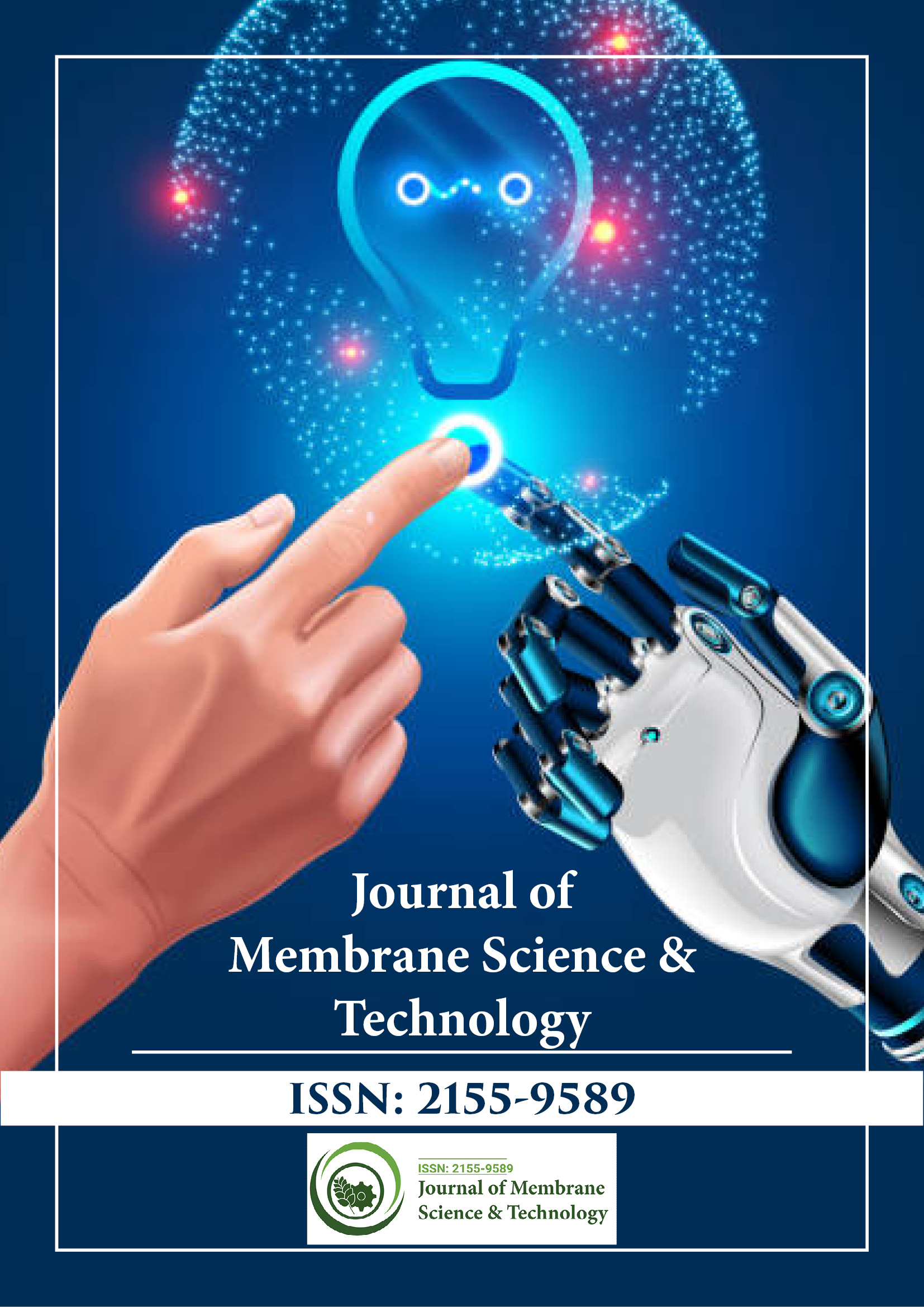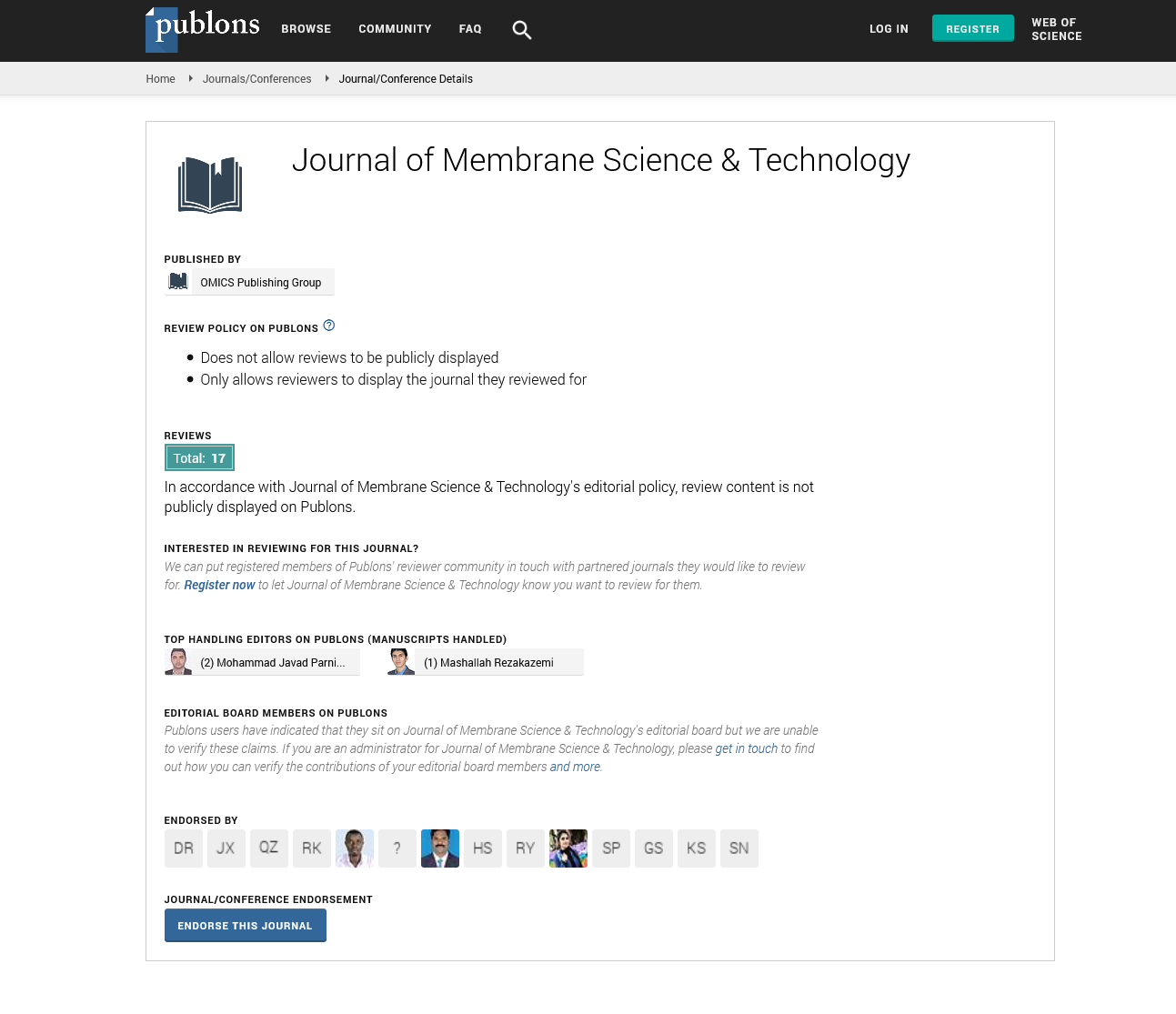Indexed In
- Open J Gate
- Genamics JournalSeek
- Ulrich's Periodicals Directory
- RefSeek
- Directory of Research Journal Indexing (DRJI)
- Hamdard University
- EBSCO A-Z
- OCLC- WorldCat
- Proquest Summons
- Scholarsteer
- Publons
- Geneva Foundation for Medical Education and Research
- Euro Pub
- Google Scholar
Useful Links
Share This Page
Journal Flyer

Open Access Journals
- Agri and Aquaculture
- Biochemistry
- Bioinformatics & Systems Biology
- Business & Management
- Chemistry
- Clinical Sciences
- Engineering
- Food & Nutrition
- General Science
- Genetics & Molecular Biology
- Immunology & Microbiology
- Medical Sciences
- Neuroscience & Psychology
- Nursing & Health Care
- Pharmaceutical Sciences
Opinion Article - (2025) Volume 15, Issue 2
Exploring Diverse Membrane Applications A cross Industrial, Environmental, and Biomedical Fields
Mohtada Sadrzadeh*Received: 30-Apr-2025, Manuscript No. JMST-25-29442; Editor assigned: 02-May-2025, Pre QC No. JMST-25-29442; Reviewed: 16-May-2025, QC No. JMST-25-29442; Revised: 23-May-2025, Manuscript No. JMST-25-29442; Published: 30-May-2025, DOI: 10.35248/2155-9589.25.15.424
Description
Membrane technology has become an essential tool across a wide array of industries due to its ability to selectively separate, purify, or concentrate specific components from complex mixtures. The adaptability, energy efficiency and scalability of membrane processes make them valuable in water treatment, food and beverage production, pharmaceuticals, energy systems and biomedical applications. As demands for sustainable technologies and high-performance separation processes grow, membrane applications continue to expand, offering innovative solutions for challenges in both traditional and emerging sectors.
One of the most widespread and critical applications of membrane technology is in water and wastewater treatment. Membranes are used in various stages of treatment, from removing suspended solids and pathogens in microfiltration and ultrafiltration processes to eliminating salts and dissolved ions through nanofiltration and reverse osmosis. In municipal and industrial settings, Membrane Bioreactors (MBRs) combine biological degradation with membrane filtration to produce high-quality effluent in a compact footprint. Desalination, particularly via reverse osmosis, relies heavily on membranes to convert seawater into potable water, playing a vital role in water-scarce regions around the world.
In the food and beverage industry, membranes are used for clarification, concentration and sterilization. Ultrafiltration is commonly employed in dairy processing to separate proteins from lactose and water, allowing the production of whey protein concentrates and isolates. In beverage production, microfiltration can remove yeast and bacteria without the need for heat, preserving flavor and nutritional quality. Reverse osmosis is also used to concentrate fruit juices while retaining aroma and taste components. These applications enhance product quality, extend shelf life and reduce energy consumption compared to traditional thermal processes.
Pharmaceutical and biotechnology industries benefit significantly from membrane processes due to the need for high purity and precision. Membranes are used in drug formulation, purification of Active Pharmaceutical Ingredients (APIs) and removal of pyrogens and endotoxins. Ultrafiltration and infiltration are widely employed in the purification of monoclonal antibodies and other biologics, ensuring product safety and efficacy. In cell culture applications, membranes facilitate the sterile filtration of growth media and reagents, supporting the production of vaccines and therapeutic proteins.
Gas separation is another important area where membranes play a transformative role. Membranes can selectively separate gases based on differences in size, solubility, or diffusivity. For instance, polymeric and inorganic membranes are used to separate oxygen from air, remove carbon dioxide from natural gas and recover hydrogen in petrochemical processes. Compared to conventional methods such as cryogenic distillation or adsorption, membrane-based gas separation is often more compact, energy-efficient and easier to operate. As efforts to reduce greenhouse gas emissions intensify, membranes are being explored for Carbon Capture and Storage (CCS) applications, where they can help isolate from flue gases and industrial emissions.
In the field of energy, membranes contribute to clean and renewable technologies. Fuel cells, which convert chemical energy into electricity, rely on Proton Exchange Membranes (PEMs) to conduct hydrogen ions while preventing fuel crossover. These membranes are central to the performance and durability of hydrogen fuel cell vehicles and stationary power systems. Additionally, membranes are used in redox flow batteries and electro dialysis systems for energy storage and ion separation, supporting grid stability and energy management in renewable energy infrastructure.
Biomedical applications of membranes encompass a range of life-saving technologies. Hemodialysis membranes are used to filter waste products and excess fluids from the blood of patients with kidney failure. These membranes must exhibit high selectivity, biocompatibility and mechanical strength to ensure safe and effective treatment. In drug delivery, membranes serve as controlled-release platforms, enabling sustained and targeted delivery of medications. Artificial organs, tissue scaffolds and wound dressings also incorporate membranes to mimic biological functions and support healing processes.
Membranes are also used in microelectronics and semiconductor manufacturing, where ultrapure water is required for wafer cleaning and processing. Reverse osmosis, ultrafiltration and degasification membranes are used in sequence to achieve the high purity standards demanded by this industry. Even minor contaminants can lead to defects in microchips, making membrane performance a critical factor in technological advancement.
Environmental applications of membrane technology continue to grow in importance. Membranes are being deployed in processes such as landfill leachate treatment, removal of micro pollutants and endocrine disruptors from wastewater and treatment of industrial effluents containing heavy metals or organic solvents. Forward osmosis, membrane distillation and pervaporation are emerging membrane processes that offer solutions for treating complex or high-salinity wastewaters where conventional methods are less effective.
The adaptability of membrane materials and configurations allows engineers and scientists to tailor systems to specific needs. Advances in nanomaterials, surface modifications and hybrid systems are pushing the boundaries of what membranes can achieve. For instance, incorporating graphene oxide or metal-organic frameworks into membrane structures can enhance selectivity, permeability and fouling resistance. Smart membranes that respond to stimuli such as pH, temperature, or magnetic fields are also being explored for responsive and adaptive applications.
Conclusion
In conclusion, membrane technology represents a versatile and increasingly indispensable tool across a wide range of industries and applications. Its role in enabling cleaner water, safer pharmaceuticals, renewable energy and advanced healthcare illustrates its far-reaching impact on modern life. As global challenges related to sustainability, health and resource scarcity intensify, the continued evolution of membrane applications will play a vital role in shaping a more efficient, resilient and environmentally responsible future.
Citation: Sadrzadeh M (2025) Exploring Diverse Membrane Applications A cross Industrial, Environmental and Biomedical Fields. J Membr Sci Technol. 15:424.
Copyright: © 2025 Sadrzadeh M. This is an open-access article distributed under the terms of the Creative Commons Attribution License, which permits unrestricted use, distribution and reproduction in any medium, provided the original author and source are credited.

